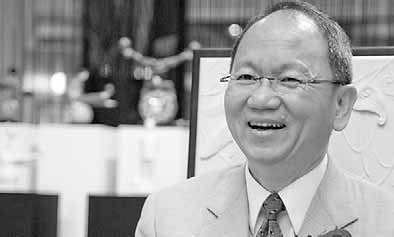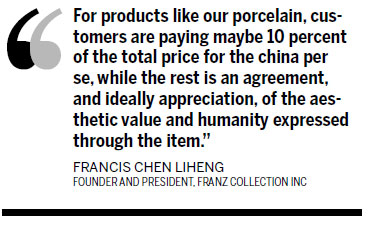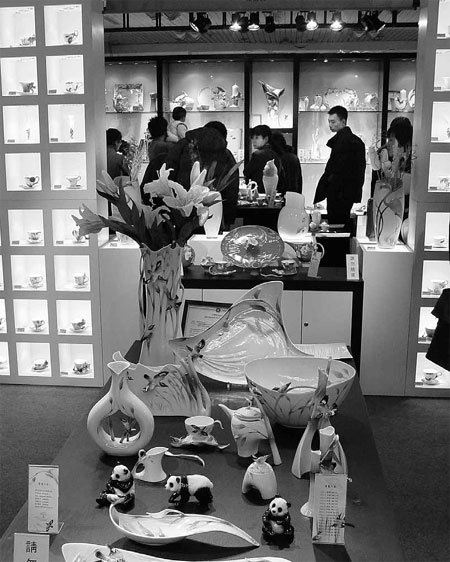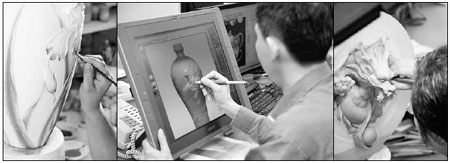The producer with China in his hand
|
A chinaware exhibition held in Beijing. High-quality chinaware works are regarded as decent gifts throughout the world. Sha Hui / China Daily |
|
Employees of Franz Collection Inc design new products in its factory in Jingdezhen, Jiangxi province. Provided to China Daily |


Chen Liheng is keen for his Franz Collection to be as admired as Wedgewood's
Francis Chen Liheng has never spent a penny advertising his wares but the founder and president of Franz Collection Inc doesn't really need to worry about his stock not shifting.
Drop-in customers who have heard about him through word of mouth include former US president Bill Clinton, Kuomintang Chairman Ma Ying-jeou, and a galaxy of world-famous celebrities including Barbra Streisand and Elton John.
"What I am selling is culture," said the 61-year-old chinamaker who described his 3,000 yuan ($480) tea set and vases that mostly feature rich colors and exquisite relief as a combination of "Eastern aesthetics and Western art nouveau".
After spending more than 10 years filling showcases with his chinaware in world-famous department stores and fine gift shops that were dominated by names such as Japan's Noritake, Germany's Meissen and Britain's Wedgewood, Chen is ambitious to move upward on the global showcase, becoming the world's top china producer.
The Taiwan native believes that to achieve his goal he should return to the Chinese mainland, the home of his produce.
"I doubt that anybody would be drinking Coca-Cola and watching Hollywood movies if Americans per se don't. A brand must be supported by the culture and social network in which it is rooted and that's why I am coming back," said Chen.
Like hundreds of original equipment manufacturers and original design manufacturers in Taiwan, a world powerhouse for products ranging from baby carriages to Christmas lights and computers, Chen made his fortune in the 1990s by manufacturing for a galaxy of world's top gift producers including the US company Legend.
In 2001, "the king of gift OEM" decided to do something more than just accumulate wealth. He began manufacturing and designing a brand of his own, the Franz Collection, named after his English name Francis.
"If there is one thing we Chinese should be good at making and selling, it is the chinaware named after our nation," said Chen, who majored in German at Taiwan Fu Jen University, and is a learned master of Confucianism, Buddhism and Taoism.
Known as the fifth invention of China, porcelain, a ceramic made by heating raw materials generally consisting of clay in the form of kaolin, used to enjoy high esteem among European aristocrats since it was first shipped there in the late 13th century. King Augustus II the Strong of Poland, for example, once traded a troop of 600 elite soldiers for 150 porcelain temple jars.
Industrious attempts to reproduce what had been termed "white gold", however, quickly outshone Chinese porcelain in the following centuries in Europe, which led to the creation of the current top china brands such as Meissen and later Wedgewood, leaving the original a limited presence in the market.
"It's just like the Chinese copying LV bags today. What is pathetic is that we don't have any original 'LV china' anymore," said Chen.
While it remains "unaffecting" for Chen if Franz becomes the latter day LV china, the company has earned quite a place in Europe and the United States.
One year after the brand was established and headquartered in the US, it was recognized at the 2002 New York International Gift Fair with the Best in Show award, which Chen believed is a "golden stepping stone" for the company to expand in the overseas market.
Since then, chinaware with the logo of a seagull and the blue-inked "Franz" has quickly garnered a total of 6,000 point-of-sales outlets in 56 countries and regions including US luxury store Saks Fifth Avenue.
Although Chen declined to reveal any information about company revenues, saying it is still a family business, and he doesn't want to "invite competitors by depicting what a lucrative market it is", it is true to say the company has been enjoying "double-digit growth" throughout the past decade, even during the global economic recession in 2008, which led to centuries-old brands such as the Anglo-Irish Wedgewood suffering severe financial difficulties.
In China, where it now has almost 150 retail stores, the company's sales have increased at a speed of 40 percent every year. It has been one of the biggest, if not the biggest, gift sellers both in terms of store numbers and revenue in domestic department stores.
The secret of its success, apart from abundant experience in original equipment manufacturing, is "an integration of Chinese aesthetics and state-of-the-art technique", Chen said.
The company uses a glazing technique that can preserve colors for thousands of years and possesses a world patent for its mold-casting technique. Each piece is fired at 1,200 C and goes through more than 100 manufacturing steps before completion. It is best known for its three-dimensional sculptures and hand-painted animals and flowers.
Chen refuses to label his products Chinese because they are "neither Western nor Chinese but both, and I don't want to lose either part of them by pleasing the other". He portrays his clients as people between the ages of 30 and 60, not too burdened financially and keen on the finer things in life.
"But I do believe there is a common eye for beauty shared by human kind, just like people will find the sunrise beautiful both in Paris and Shanghai," he added.
The company has around 2,000 employees at two factories that manufacture millions of pieces sold around the world. They are in Shenzhen, Guangdong province, and Jingdezhen, Jiangxi province, the country's, if not the world's, most famous porcelain-producing centers.
Each year, it introduces 200 new designs to refresh its offerings, which number about 1,000.
Chen said the company is never short of ideas to create new designs because it is "building a brand based on a history and an empire of more than 5,000 years".
"For products like our porcelain, customers are paying maybe 10 percent of the total price for the china per se, while the rest is an agreement, and ideally appreciation, of the aesthetic value and humanity expressed through the item," said Chen.
"Every year we invest tens of millions of yuan in research and development to upgrade our designs and the technology that helps to realize the wild fantasy of the design," he added.
Despite the fact that overseas sales still outnumber domestic ones, accounting for 65 percent of the total, Chen said that the mainland is quickly catching up with a large proportion - at least 60 percent - made up of "purposeful gifting".
"In Europe, private use is the main reason dominating the market, while in Taiwan it is shared equally between private use, collection and gifting," said Chen.
A recent study conducted by the Hurun Report, China Rich List and Their Evolving Lifestyles, found that porcelain was ranked the fourth favorite item for collecting by China's richest people, after watches, classical art and drinks. For personal investment, art came second, after property, on the list.
"Traditional items collected by the rich such as cars and trophy properties have gradually fallen out of the list, coming to sixth and seventh in the 'What do you like collecting?' section, while those considered 'of better taste' and 'low-profile' are rapidly on the rise, which reflects growing interest in sophistication," said Rupert Hoogewerf, chairman and chief researcher of the Hurun Report, at a forum in Shanghai late in March.
"If you define luxury correctly, China has got its own luxury already, such as tea, china, jade and Moutai ... the country's rich are not hiding their interest in these things at all," added Hoogewerf.
Chen, however, is not concerned about selling his products as luxuries. He cooperates with luxury fashion houses such as Lanvin and historical sites including the Palace Museum in Beijing to launch limited edition chinaware that could be as expensive as 400,000 yuan apiece. Chen is rather careful about the luxury label. He believes according to its Chinese characters it is a negative word meaning "the more you have, the more people will keep their eyes on you".
Aside from the problem of shortage of talent that has befallen many Chinese entrepreneurs, Chen said that what has troubled him most is that he has seen copycats of his delicate, pricey tea sets.
He said he is helpless regarding that, adding jokingly that perhaps to be counterfeited is "one of the qualifications to be a brand in China".
He said he would learn to accept it if it was also a part of the deal to be the world's top china producer, a position in his view still occupied by Wedgewood.
"From my perspective, to be number one is not judged by how much money you make or how many stores you open, because my intention is not to make money as a priority. It's the influence and changes you leave to the industry and posterity that matter most. I think Mr Wedgewood is incomparable in the industry," he said.
"And for me, I would be perfectly satisfied if, centuries later, someone would treat Franz as a treasure after discovering it buried," he said.
xujunqian@chinadaily.com.cn
(China Daily 05/10/2012 page14)
















